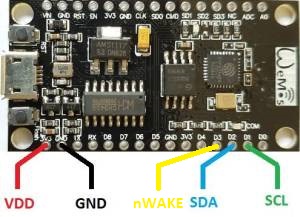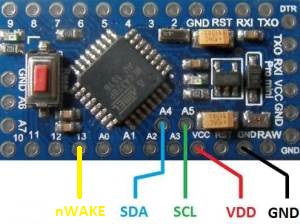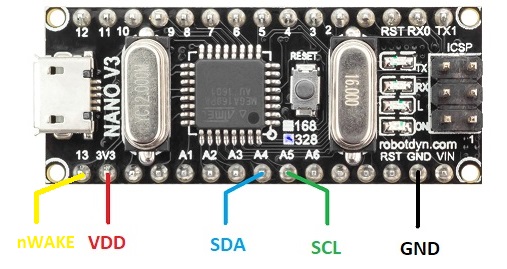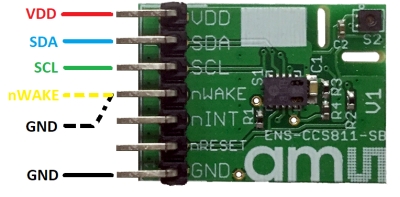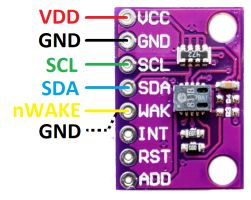Arduino library for the CCS811 digital gas sensor for monitoring indoor air quality from ams.
This project is an Arduino library. It implements a driver for the CCS811. This chip is a indoor air quality sensor module with an I2C interface.
The code has been tested with
Note that the CCS811 requires a supply voltage of 1.8V .. 3.6V. So, 3.3V is ok, but do not use a 5V board. The Nano has 3v3 supply, but runs I2C on 5V. This does seem to work. Also note that the minimum supply voltage is 1.8V and should not drop below this value for reliable device operation.
The CCS811 is made by ams.
- Find the datasheet of the CCS811 on the product page.
- Find application notes and software on the Technical Documents tab.
- Find the latest in-chip firmware on the Tools & Support tab: CCS811_SW000246_x-xx.bin.
It is assumed that
- The Arduino IDE has been installed. If not, refer to "Install the Arduino Desktop IDE" on the Arduino site.
- The Arduino library directory is at its default location.
For me, Maarten, that is
C:\Users\maarten\Documents\Arduino\libraries.
Installation steps
- Visit the project page for the Arduino CCS811 library.
- Click the green button
Clone or downloadon the right side. - From the pop-up choose
Download ZIP. - In Arduino IDE, select Sketch > Include Library > Manage Libraries ... and browse to the just downloaded ZIP file.
- When the IDE is ready this
README.mdshould be located at e.g.C:\Users\maarten\Documents\Arduino\libraries\CCS811\README.md.
To build an example sketch
- (Re)start Arduino.
- Open File > Example > Examples from Custom Libraries > CCS811 > ccs811basic.
- Make sure Tools > Board lists the correct board.
- Select Sketch > Verify/Compile.
The CCS811 has several pins:
- VDD must be connected to 3V3.
- GND must be connected to GND.
- SDA must be connected to SDA of micro (and maybe a pull-up, but the below micros have that internally).
- SCL must be connected to SCL of micro (and maybe a pull-up, but the below micros have that internally).
- nWAKE can either be tied to GND, in which case the CCS811 is always awake (using more power).
Alternatively nWAKE can be tied to a GPIO pin of the micro, the CCS library will then use this pin to wake-up the micro when needed.
In the former case pass -1 to the constructor
CCS811 ccs811(-1), in the latter case, pass the pin number, e.g.CCS811 ccs811(D3). - nINT can be left dangling, interrupts are not used by the library.
- nRESET can be left dangling, it is not used by the library (the library employs a software reset).
- When ADDR is connected the GND, the CCS811 has slave address 0x5A (constant
CCS811_SLAVEADDR_0). When ADDR is connected the VDD, the CCS811 has slave address 0x5B (constantCCS811_SLAVEADDR_1). If your board has an ADDR pin, then likely it has a pull-up, so leaving it dangling selects 0x5B. If your board has no ADDR pin, then likely it has the pin tied to GND, selecting 0x5A. Theccs811.begin()uses the address passed in the constructor, but if the other address does work, it prints this on Serial.
This library has been tested with three boards.
Most micro controllers seem to have built-in pull-ups for I2C.
However, those pull-ups are typically activated by Wire.begin().
Therefore, between power-up (or reset) and Wire.begin(), the I2C lines might not be high.
This might cause unwanted behavior on the slaves.
It is recommended to add 10k pull-ups on both SDA and SCL.
For the NodeMCU (ESP8266), connect as follows (I did not use pull-ups, presumably they are inside the MCU)
| CCS811 | ESP8266 |
|---|---|
| VDD | 3V3 |
| GND | GND |
| SDA | D2 |
| SCL | D1 |
| nWAKE | D3 or GND |
Unfortunately, the CCS811 uses clock stretching, and the I2C sw library in the ESP8266
can not handle this in all cases, therefore this library add waits (see set_i2cdelay() in ccs811.h).
However, the real solution is to fix the clock stretch problem in the ESP8266 core libraries.
I have submitted an issue for that.
You can do this yourself: open the directory with core libaries (on my pc they are in
C:\Users\mpen\AppData\Local\Arduino15\packages\esp8266\hardware\esp8266\2.4.2\cores\esp8266)
and edit core_esp8266_si2c.c. You need to add one line to both functions: twi_writeTo() and twi_readFrom().
This line needs to be added after SCL_HIGH(), it implements a wait as long as the slave stretches the clock.
unsigned int t=0; while (SCL_READ() == 0 && (t++) < twi_clockStretchLimit); // Clock stretching
See this screen shot for the change I made.
For the Pro mini (do not use a 5V board), connect as follows (I did not use pull-ups, presumably they are inside the MCU)
| CCS811 | Pro mini |
|---|---|
| VDD | VCC |
| GND | GND |
| SDA | A4 |
| SCL | A5 |
| nWAKE | D3 or GND |
For the Arduino Nano, connect as follows (I did not use pull-ups, presumably they are inside the MCU)
| CCS811 | Nano |
|---|---|
| VDD | 3V3 |
| GND | GND |
| SDA | A4 |
| SCL | A5 |
| nWAKE | D3 or GND |
Connect the official ams CCS811 module, which also has an ENS210, as follows
An alternative is a CCS811-only board (without and ENS210). Wire it as follows
To build an example sketch
-
(Re)start Arduino.
-
Open File > Example > Examples from Custom Libraries > CCS811 > ccs811basic.
-
Make sure Tools > Board lists the correct board.
-
Select Sketch > Upload.
-
Select Tools > Serial Monitor.
-
Enjoy the output, which should be like this for
ccs811basic:Starting CCS811 basic demo init: hardware version: 12 init: bootloader version: 1000 init: application version: 2000 CCS811: waiting for (new) data CCS811: waiting for (new) data CCS811: waiting for (new) data CCS811: waiting for (new) data CCS811: eco2=400 ppm etvoc=0 ppb CCS811: eco2=405 ppm etvoc=0 ppb CCS811: eco2=405 ppm etvoc=0 ppb CCS811: eco2=407 ppm etvoc=1 ppb CCS811: eco2=405 ppm etvoc=0 ppb CCS811: eco2=400 ppm etvoc=0 ppb CCS811: eco2=400 ppm etvoc=0 ppb CCS811: eco2=405 ppm etvoc=0 ppb CCS811: eco2=405 ppm etvoc=0 ppb CCS811: eco2=405 ppm etvoc=0 ppb -
It is normal that early measurements have
errstat=90=--vhxmrwF--Ad-ie, i.e. STATUS.DATA_READY clear (the lowercased); the internal gas library needs some data points to startup. -
At the time of writing this application,
application version: 2000is available on the ams.com website. You might still have version 1100. To Flash it, you need the CCS811 eval kit. As an alternative, you could try the flash example - on your own risk.
(end of doc)
